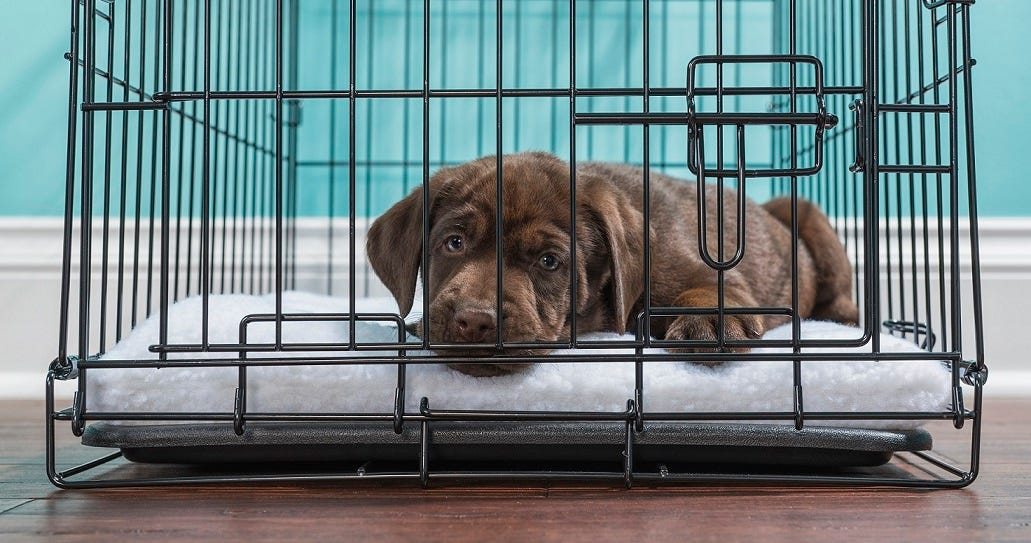As a new puppy owner, you might find yourself overwhelmed with information - especially in the area of crate training puppy and dogs. Some owners feel guilty about their pup spending time in a crate, worrying that the confined space is seen as a punishment. However, crate training actually has a lot of benefits for both you and your pup.
Crate training a puppy can help with:
- Toilet-training. Your doggo won’t want to soil where they sleep!
- House training by limiting your pups access to the house while they learn the house rules.
- Adjustment to travelling for vet visits or car rides. .
- Creating a safe place for your pup to hide when they feel nervous or scared.
How to find the perfect puppy crate
When it comes to crate training your new puppy, you're going to want to make sure you have the right size that creates a comfortable fit!
The crate should be big enough for your dog to stand up and turn around comfortably. Most puppy crates come in with measurement guides, so make sure you know your pups length, height, current weight and anticipated fully-grown weight.
Most crate for puppies come with a temporary divider. That way you can reduce the crate size when they're still a young pup, but make it bigger as they grow. By reducing the space when they're young, you'll help prevent any toilet accidents in one corner of their sleeping area.
How to crate train a puppy
Puppy crate training will take time and plenty of patience! You might find you need to adjust your crate training puppy schedule to suit your pup!
Step 1: Before you start, make sure you have plenty of treats on hand! You’ll also want to make sure your puppy crate is comfortable and welcoming.
Step 2: Introduce your pup to the crate. Make sure to keep the crate in an area where you and your family are so they don’t feel like they’re being punished!
Step 3: Encourage them to go inside the crate with their favourite toy or treat - never force them inside! Instead, remain patient and let them enter at their own pace. Keep the crate door open for now.
Step 4: Once your pup is familiar with the crate, you can begin feeding them their regular meals there. If your pup is still a little hesitant, start small. First place the food bowl near the crate, but still on the outside. Then closer until the bowl is inside the crate.
Step 5: Encourage your pup to stay in the crate for a longer period of time. You can try and create a command like ‘crate’ or ‘house’ to encourage them to enter. Make sure to reward them with their favourite treat!
Step 6: Once they become a little more comfortable with the crate, close the door. Sit quietly near them for a few minutes, then leave the room. Make sure to come back after a few minutes and then let them out. Repeat this a few times!
Step 7: Gradually increase the time your pup is in the crate until it reaches half an hour. Once your pup is calm and quiet while staying in the crate, you should feel confident leaving them for longer periods of time!
Crate safety tips
- Don’t leave your pup alone for long periods of time at the start
- Don’t leave them with a toy or treat that may pose a safety hazard if left unsupervised
- Make sure the crate is a refuge – never use it as a punishment
- Remove your puppy’s collar before crating
- Never leave your puppy in a crate for more than a few hours. Behaviours like a puppy crying in crate may signal that they need a toilet break!
Crate training your puppy at night
Crate training can prove particularly beneficial at night time. You’ll find that your pup will actually seek out their crate to sleep. After all, dog’s actually have a natural instinct to seek out a quiet, safe place to rest and sleep. Before you settle them in for the night, make sure they burn off some energy so they’re not ready for play when they should be sleeping.
To start, it might be wise to keep the crate in your bedroom or nearby in a hallway. This way they will still feel close to you! Plus, you’ll also be able to hear when your pup needs to go outside for a toilet break.
FAQ:
What is crate training your puppy?
Crate training teaches your dog that a crate is a safe, personal space for them in your home. It draws on your dog's natural instincts to create a den to sleep and hide.
When to start crate training a puppy?
It’s best to start crate training when your dog is a puppy. Although adult dogs can be crate trained, you might find the process isn’t as smooth and will take longer.
When should you avoid crate training your new puppy?
You should also avoid crating your dog for a long period of time. Adult dogs shouldn’t be left for more than 4 hours while pups should only remain in a crate for a maximum of 2 hours.
If your puppy has claustrophobia or separation anxiety issues, a crate may stress them out even more. Always speak to your vet if you have concerns that crating may lead to panicked or frantic attempts to escape.
























